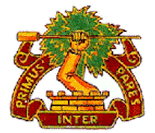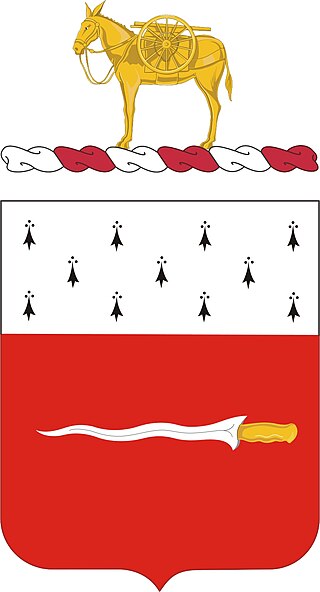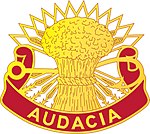
The 1st Air Defense Artillery is an air defense artillery regiment in the United States Army first formed as a field artillery unit in 1821.

The 2nd Field Artillery Regiment is a field artillery regiment in the United States Army. Currently a parent regiment under the U.S. Army Regimental System, the regiment has a single active battalion, the 2nd Battalion, 2nd Field Artillery, assigned to the 428th Field Artillery Brigade at the U.S. Army Field Artillery, Fort Sill, OK. Their long history is currently represented by the 2nd Field Artillery Mascots

The 2nd Battalion, 1st Air Defense Artillery Regiment is a battalion in the 1st Air Defense Artillery Regiment, a regiment in the United States Army, first formed in 1812, and based in South Korea.

The 52nd Air Defense Artillery Regiment is an air defense artillery regiment of the United States Army first organized in 1917 as a railway gun unit. It continued in that role unit 1943, when the regiment was broken in separate railway gun battalions, and in the following year the units were reorganized and redesignated as field artillery.

The 2nd Air Defense Artillery Regiment is an air defense artillery regiment of the United States Army, first formed in 1821 as a field artillery unit.
The 11th Coast Artillery was a coast artillery regiment in the United States Army, first constituted in the Regular Army on 27 February 1924. It primarily served as the Regular Army component of the Harbor Defenses of Long Island Sound, New York from 1924 through 1944, when it was relieved and disbanded as part of an Army-wide reorganization.

The 5th Air Defense Artillery Regiment is an Air Defense Artillery regiment of the United States Army, first formed in 1861 in the Regular Army as the 5th Regiment of Artillery.

The 3rd Air Defense Artillery Regiment is an air defense artillery regiment of the United States Army, first formed in 1821 as the 3rd Regiment of Artillery.

The 7th Air Defense Artillery Regiment is an air defense artillery regiment of the United States Army, first constituted in the Regular Army as the 7th Regiment of Artillery on 8 March 1898. The 6th and 7th U.S. Artillery Regiments were constituted on 8 March 1898, three weeks after the explosion of USS Maine in Havana, Cuba on 15 February 1898, as the United States' declaration of war on Spain and commencement of the Spanish–American War seemed imminent.

The 6th Air Defense Artillery Regiment is an air defense artillery regiment in the United States Army, first formed in 1898 as the 6th Regiment of Artillery. The 6th and 7th U.S. Artillery Regiments were constituted on 8 March 1898, three weeks after the explosion of the USS Maine in Havana, Cuba on 15 February 1898, as the United States' declaration of war on Spain and commencement of the Spanish–American War seemed imminent.
The 9th Coast Artillery Regiment was a Coast Artillery regiment in the United States Army.
The 10th Coast Artillery Regiment was a Coast Artillery regiment in the United States Army. It primarily served as the Regular Army coast artillery component of the Harbor Defenses (HD) of Narragansett Bay, Rhode Island from 1924 through 1944, when it was relieved and disbanded as part of an Army-wide reorganization.
The 13th Coast Artillery Regiment was a Coast Artillery regiment in the United States Army. Elements of the regiment served during World War II in the Harbor Defenses of Pensacola, HD Key West, HD Galveston, HD Charleston, Temporary HD of New Orleans, and in Bora Bora in the South Pacific. The regiment was broken up and its elements redesignated on 31 August 1944 as part of an Army-wide reorganization.
The 14th Coast Artillery Regiment was a Coast Artillery regiment in the United States Army. It served as the Regular Army component of the Harbor Defenses (HD) of Puget Sound, Washington state from 1924 through October 1944, when it was broken up and disbanded as part of an Army-wide reorganization. The 248th Coast Artillery Regiment was the Washington National Guard component of those defenses.

The 15th Coast Artillery was a Coast Artillery Corps regiment in the United States Army. Along with the 16th Coast Artillery, it manned the Harbor Defenses of Pearl Harbor and other fortified sites on Oahu, Hawaii from 1924 until broken up into battalions in August 1944 as part of an Army-wide reorganization.
The 61st Air Defense Artillery Regiment is an air defense artillery regiment in the United States Army. The lineages of some of the units that initially made up the 61st Artillery (CAC) give the regiment's 1st Battalion campaign credit for the War of 1812.

The 265th Air Defense Artillery Regiment is an air defense artillery regiment in the Florida Army National Guard. The unit was formed 19 October 1923 in the Florida National Guard as the 1st Separate Battalion, Coast Artillery Corps. It was reorganized and redesignated as the 265th Coast Artillery Regiment (CA) (HD) in 1929. The 265th was activated for World War II and served in the harbor defenses of Galveston, Texas, Los Angeles, California, Key West, Florida, Sandy Hook, New Jersey, and Alaska until broken up into battalions in July 1944. The unit lineage was carried by two antiaircraft battalions organized in 1946, one of which was federalized in Florida during the Korean War. Consolidated with other units in 1959 as the 265th Artillery; reorganized in 1987 as the 265th Air Defense Artillery.
The 19th Coast Artillery Regiment was a Coast Artillery regiment in the United States Army. It was the garrison of the Harbor Defenses of San Diego, replacing the 3rd Coast Artillery there. The regiment was active from 1940 until broken up into battalions and partially inactivated in October 1944 as part of an Army-wide reorganization.
The 23rd Coast Artillery Regiment was a Coast Artillery Corps regiment in the United States Army. It was the garrison of the Harbor Defenses of New Bedford, Massachusetts in World War II, as a battalion in February 1940 through expansion to a regiment in September 1943, then reduced to a battalion in February 1944 until inactivated in October 1944.

The 429th Brigade Support Battalion is a combat service support battalion of the United States Army and the Virginia National Guard. It is part of the 116th Infantry Brigade Combat Team, Virginia Army National Guard.














